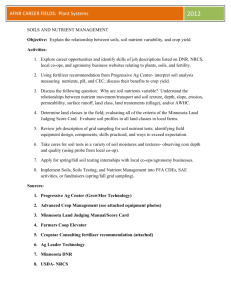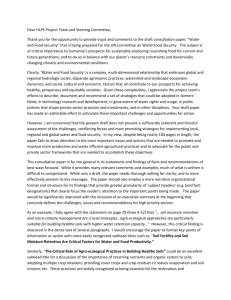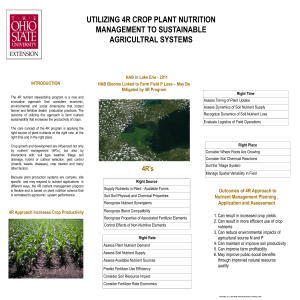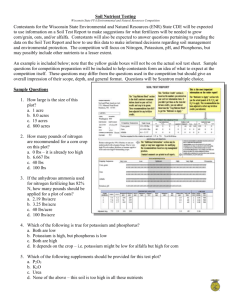How will you feed your crops? worksheet
advertisement
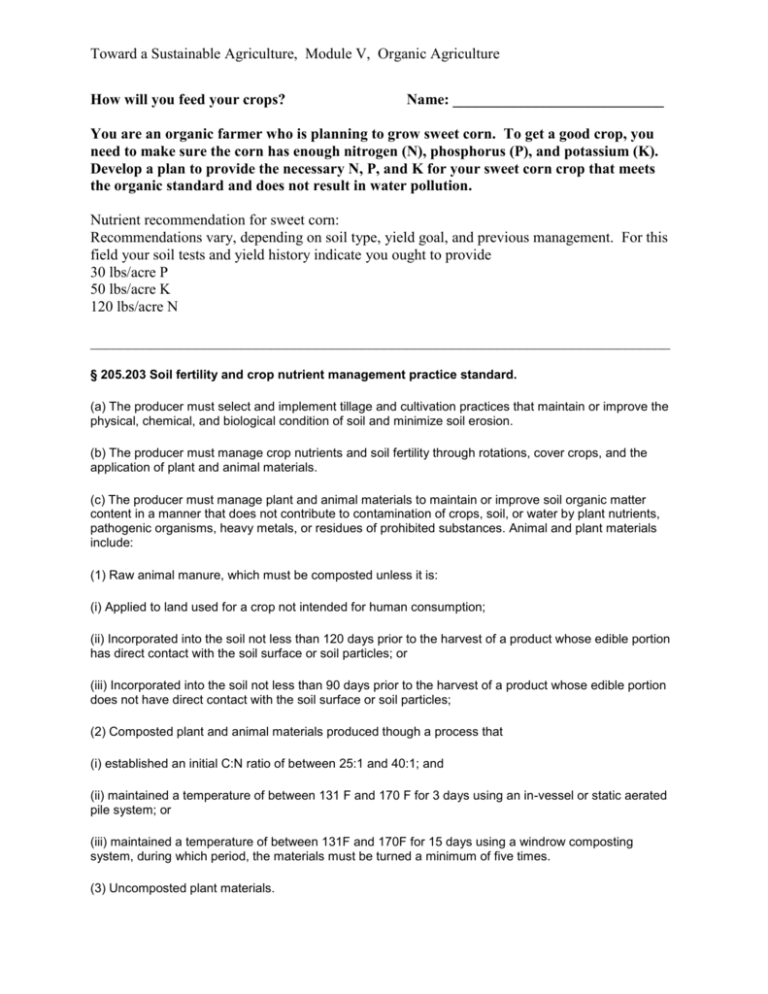
Toward a Sustainable Agriculture, Module V, Organic Agriculture How will you feed your crops? Name: ____________________________ You are an organic farmer who is planning to grow sweet corn. To get a good crop, you need to make sure the corn has enough nitrogen (N), phosphorus (P), and potassium (K). Develop a plan to provide the necessary N, P, and K for your sweet corn crop that meets the organic standard and does not result in water pollution. Nutrient recommendation for sweet corn: Recommendations vary, depending on soil type, yield goal, and previous management. For this field your soil tests and yield history indicate you ought to provide 30 lbs/acre P 50 lbs/acre K 120 lbs/acre N _____________________________________________________________________________ § 205.203 Soil fertility and crop nutrient management practice standard. (a) The producer must select and implement tillage and cultivation practices that maintain or improve the physical, chemical, and biological condition of soil and minimize soil erosion. (b) The producer must manage crop nutrients and soil fertility through rotations, cover crops, and the application of plant and animal materials. (c) The producer must manage plant and animal materials to maintain or improve soil organic matter content in a manner that does not contribute to contamination of crops, soil, or water by plant nutrients, pathogenic organisms, heavy metals, or residues of prohibited substances. Animal and plant materials include: (1) Raw animal manure, which must be composted unless it is: (i) Applied to land used for a crop not intended for human consumption; (ii) Incorporated into the soil not less than 120 days prior to the harvest of a product whose edible portion has direct contact with the soil surface or soil particles; or (iii) Incorporated into the soil not less than 90 days prior to the harvest of a product whose edible portion does not have direct contact with the soil surface or soil particles; (2) Composted plant and animal materials produced though a process that (i) established an initial C:N ratio of between 25:1 and 40:1; and (ii) maintained a temperature of between 131 F and 170 F for 3 days using an in-vessel or static aerated pile system; or (iii) maintained a temperature of between 131F and 170F for 15 days using a windrow composting system, during which period, the materials must be turned a minimum of five times. (3) Uncomposted plant materials. Toward a Sustainable Agriculture, Module V, Organic Agriculture (d) A producer may manage crop nutrients and soil fertility to maintain or improve soil organic matter content in a manner that does not contribute to contamination of crops, soil, or water by plant nutrients, pathogenic organisms, heavy metals, or residues of prohibited substances by applying: (1) A crop nutrient or soil amendment included on the National List of synthetic substances allowed for use in organic crop production; (2) A mined substance of low solubility; (3) A mined substance of high solubility, Provided, That, the substance is used in compliance with the conditions established on the National List of nonsynthetic materials prohibited for crop production; (4) Ash obtained from the burning of a plant or animal material, except as prohibited in paragraph (e) of this section: Provided, That, the material burned has not been treated or combined with a prohibited substance or the ash is not included on the National List of nonsynthetic substances prohibited for use in organic crop production; and (5) A plant or animal material that has been chemically altered by a manufacturing process: Provided, That, the material is included on the National List of synthetic substances allowed for use in organic crop production established in § 205.601. (e) The producer must not use: (1) Any fertilizer or composted plant and animal material that contains a synthetic substance not included on the National List of synthetic substances allowed for use in organic crop production; (2) Sewage sludge (biosolids) as defined in 40 CFR Part 503; and (3) Burning as a means of disposal for crop residues produced on the operation: Except, That, burning may be used to suppress the spread of disease or to stimulate seed germination. ___________________________________________________________________________________ You can look up nutrient values for selected raw, dried, and composted manures at http://www.extension.umn.edu/distribution/horticulture/M1192.html You can look up nutrient values for raw manure at http://hubcap.clemson.edu/~blpprt/table1.html You can look up nutrient values for composted dairy manure at http://compost.tamu.edu/docs/pubs/Economics.pdf You can look up nitrogen credits for alfalfa at http://www.extension.umn.edu/cropenews/2005/05MNCN03.htm Toward a Sustainable Agriculture, Module V, Organic Agriculture Estimated nutrient availability from 1 ton of dairy manure compost Nutrient Year 1 Year 2 Year 3 -------------------------------------- lb -------------------------------------------------------N P2O5 K2 O 9.38 12.20 15.90 4.69 6.10 7.95 2.34 3.05 3.98 PREPARED IN COOPERATION WITH THE TEXAS COMMISSION ON ENVIRONMENTAL QUALITY AND U.S. ENVIRONMENTAL PROTECTION AGENCY The preparation of this report was financed through grants from the U.S. Environmental Protection Agency through the Texas Commission on Environmental Quality. http://compost.tamu.edu/docs/pubs/Economics.pdf Ec Estimated nutrient availability from 1 ton of raw, bedded dairy manure -------- lb -------N 9 P2O5 4 K2O 10 University of Minnesota Extension “Using Manure and Compost as Nutrient Sources for Fruit and Vegetable Crops” http://www.extension.umn.edu/distribution/horticulture/M1192.html Nitrogen credits from a healthy alfalfa stand range from about 100 to 150 lbs/acre in the first year following alfalfa and from about 50 to 75 lbs/acre for the second year following the crop. The nitrogen credit from an excellent cover crop of hairy vetch is about 110 lbs/acre. Minnesota Crop e-news, January 6 2005 http://www.extension.umn.edu/cropenews/2005/05MNCN03.htm ; Fred Magdoff and Harold van Es, Building Soils for Better Crops, p. 160, http://www.sare.org/publications/bsbc/bsbc.pdf

